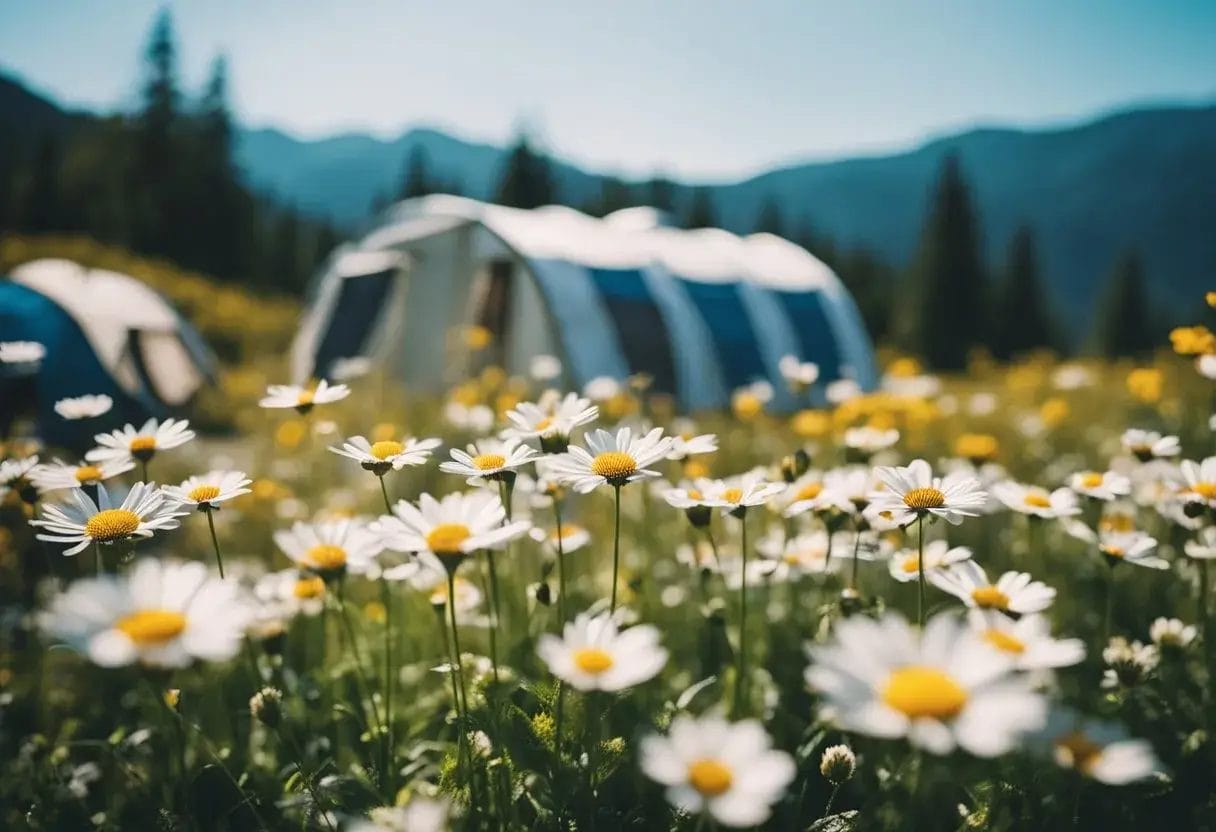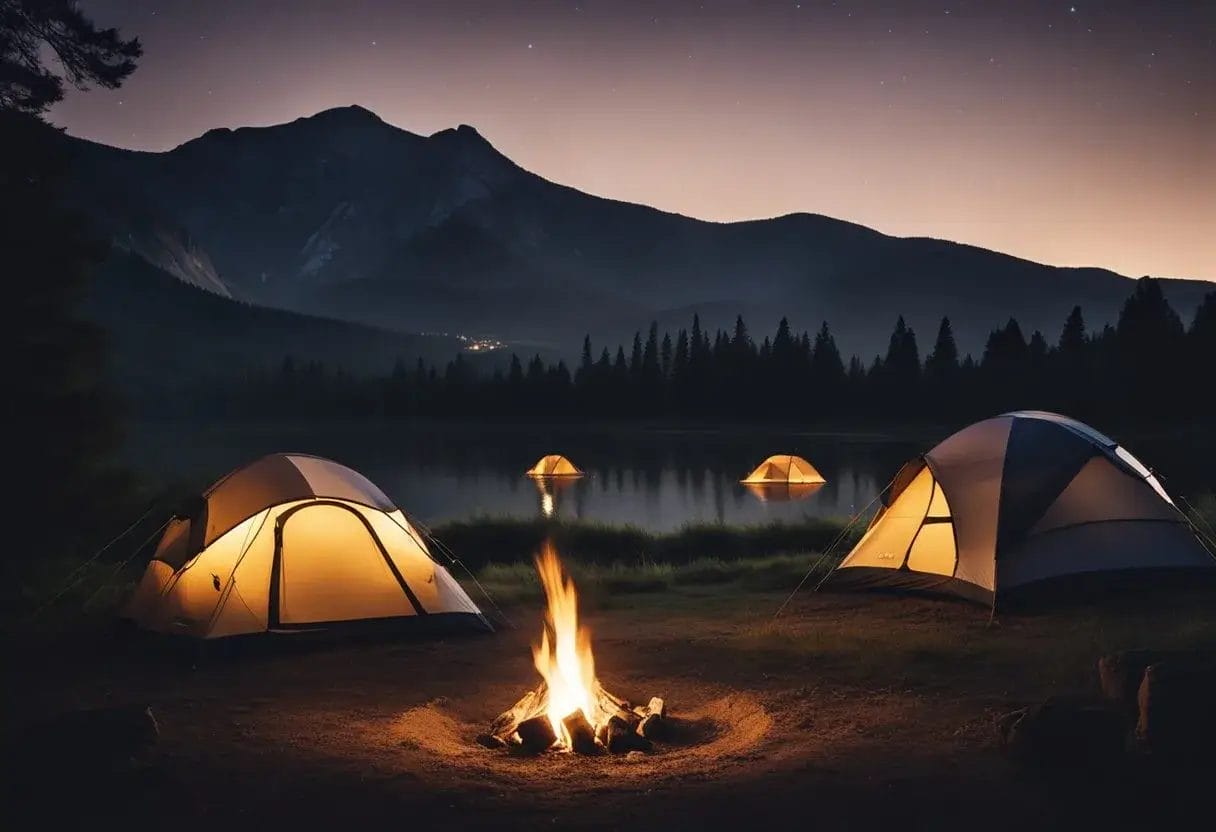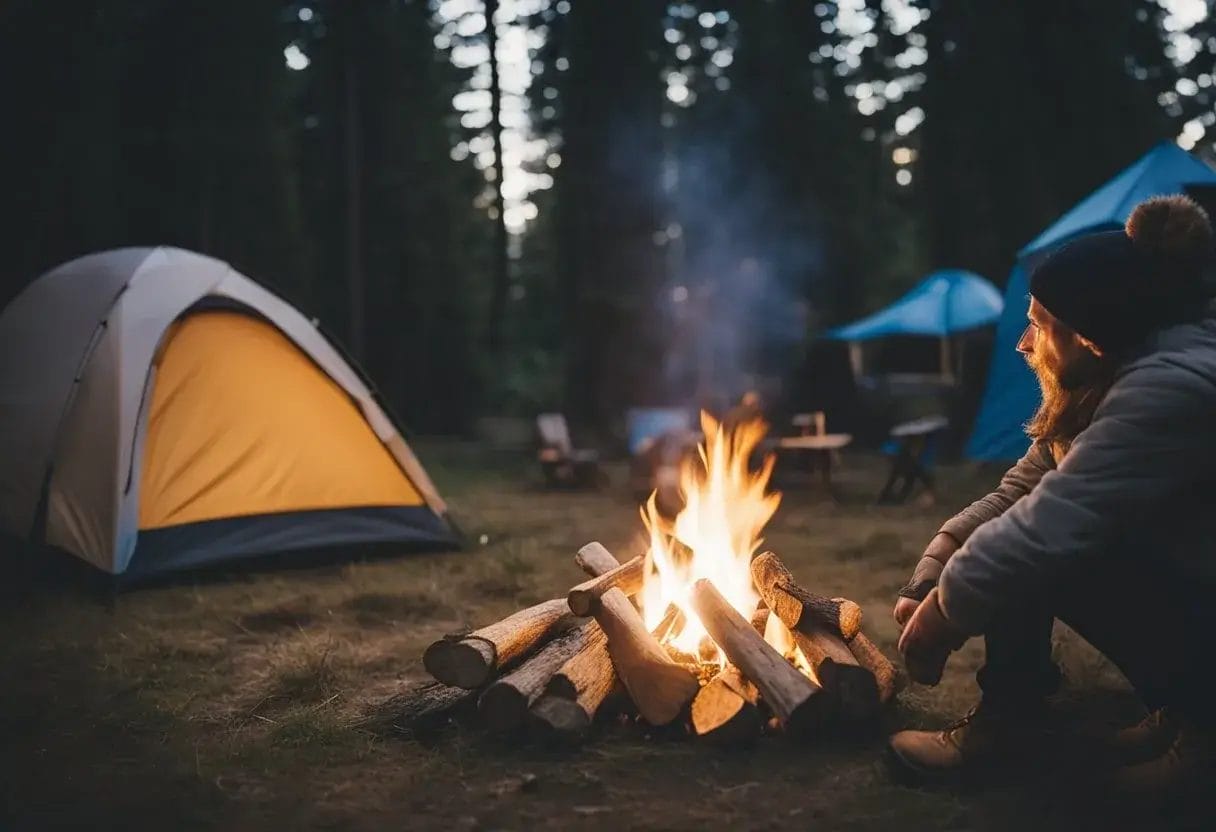When Does Camping Season Start: Best Times to Plan Your Adventure
Camping season is a time many outdoor enthusiasts eagerly anticipate. The start of this season largely depends on various factors such as weather conditions, location, campground openings, and personal preferences. For most locations in the United States, the camping season generally starts in spring, around April or May, as the weather starts to warm up and the snow melts. However, the best time for camping is a matter of personal preference. It varies for everyone, as some may prefer less crowded campgrounds, milder weather, or specific activities unique to certain seasons.

Understanding the prime camping seasons in different regions will aid in planning the perfect camping trip. While spring may be ideal for some locations, other areas might see the best camping weather during the summer or fall months. For instance, campgrounds in the southern United States may have higher temperatures during the summer. Camping in the fall would provide a better experience for those who prefer milder weather.
Key Takeaways
- Camping season typically starts in spring, around April or May, depending on various factors such as location and weather conditions.
- The best time for camping varies for every individual as preferences for weather, crowd levels, and desired activities vary.
- Researching regional weather patterns and campground opening dates is crucial to ensure a safe and enjoyable camping experience.
Table of Contents
Understanding Camping Seasons
Seasonal Variations in Camping
Camping season generally begins in late spring as the weather begins to warm up, making it more suitable for outdoor activities. The start of the season varies slightly depending on location, climate, and other factors. In the US, for instance, camping season often kicks off in April or May and lasts until October.
During the summer months, campers enjoy the warm weather and longer days, perfect for exploring trails, swimming, and outdoor activities. As temperatures cool down in fall, campgrounds become quieter, offering a more tranquil experience for those who appreciate the beauty of autumn foliage.
Winter months bring cooler temperatures and varied conditions, depending on location. Camping in snowy regions can be a unique experience for adventurous campers, whereas milder climates offer a more comfortable camping experience during winter.
Conversely, spring offers a time of renewal. As temperatures begin to rise and nature starts to bloom, camping in early to late spring provides campers with mild temperatures to enjoy the outdoors.
Camping Season Overview by Region
The US:
- Northeast: camping is popular from May to October, but nature enthusiasts may camp year-round amid the region’s varying climatic conditions.
- Southeast: March to November is optimal for camping in this region, thanks to warm weather and high humidity during summer.
- Midwest: April to October is a great time to visit Midwestern campgrounds, although off-season camping is also popular in more mild states.
- West Coast: Camping season tends to start early in coastal states like California and Oregon, with late April to early May offering pleasant conditions.
Climate Considerations:
- Warm Weather: Typically experienced from late spring to early fall, warm weather attracts the most campers who are eager to make the most of the sunshine and outdoor activities.
- Mild Temperatures: Experienced during spring and fall, ideal for campers looking for a less crowded and more comfortable camping experience.
- Cooler Temperatures: Late fall and winter can be a great time to camp in areas with mild winter conditions, but may not be suitable for colder regions with snow or freezing rain.
Weather, temperature, and regional characteristics play a significant role in determining the ideal camping season. Overall, understanding seasonal variations in camping and regional differences is crucial for campers wishing to plan an enjoyable and memorable outdoor adventure.
Best Times to Camp
Factors such as weather patterns and personal preferences can impact the camping experience. This section will explore the prime camping months and off-peak camping opportunities.

Prime Camping Months
The prime camping months are generally May through September when the weather is pleasant and suitable for outdoor activities. Campers can enjoy summer camping experiences with warm temperatures and abundant daylight during this period. The most popular months for camping are June, July, and August due to their predictable weather patterns and school vacations for families. However, peak season often corresponds with crowded campgrounds, so booking in advance is recommended if you don’t mind the crowds.
Summer Camping:
- June: Longer daylight hours, mild temperatures, and blooming flora.
- July: Warm and predictable weather, making it perfect for outdoor activities.
- August: Similar to July, camping is still warm and enjoyable but can start getting cooler towards the end of the month.
Fall camping, on the other hand, offers a different experience, with September and October showcasing the beauty of changing foliage colors and cooler temperatures. Wildlife is often more active during this shoulder season, providing a treat for nature enthusiasts.
Fall Camping:
- September: Mild weather, fewer crowds, and spectacular fall foliage in many regions.
- October: Cooler temperatures and continued fall colors, but prepare for colder nights.
Off-Peak Camping Opportunities
Outside the prime camping months, off-peak camping opportunities still exist for those open to more unique experiences. Winter camping, for example, offers unmatched tranquility, breathtaking snowy landscapes, and winter sports like skiing or snowshoeing. Remember that some campgrounds may close during winter, so check for up-to-date information before heading out on a winter camping adventure.
Winter Camping:
- Peaceful and uncrowded campgrounds.
- Enjoy winter sports and activities.
- Snow-covered landscapes and scenery.
- My favorite part – NO BUGS!
In summary, the best time to go camping depends on personal preferences and desired activities. The prime camping months offer predictable weather and abundant opportunities for outdoor fun, while off-peak camping allows for unique and less crowded experiences. Regardless of when you choose to camp, always ensure you are prepared for the specific season’s weather conditions and campground availability.
** If you’ll be winter camping with your dogs you may enjoy this article.
Selecting the Right Campground

National vs. State Park Campgrounds
When planning a camping trip, consider staying at a National Park or a State Park campground. National Parks are known for their iconic landscapes and often attract way more visitors, while State Parks tend to be quieter and easier to find a campsite. They also tend to be more pet friendly if you’re camping with dogs. The choice often depends on the desired experience, location, and the available facilities at each park.
National Park campgrounds usually provide a more immersive experience in the natural environment. They often offer well-maintained facilities, including restrooms, shower areas, and easy access to popular trails and attractions. On the other hand, State Park campgrounds might be smaller with less crowded campsites and offer more opportunities for local recreational activities, such as fishing or hiking on less crowded trails.
Amenities and Accessibility
Tent camping and RV camping are the two main types of camping experiences. Campgrounds usually provide different facilities and amenities for each.
- Tent Camping: Most tent campsites have a fire ring, picnic table, and access to shared facilities such as restrooms and water sources. Some campgrounds may also offer showers and on-site stores.
- RV Camping: RV campsites typically have necessary utilities like electric and water hookups. Some might offer sewer connections or dump stations; others even provide amenities like Wi-Fi or Cable TV.
| Camping Type | Key Amenities |
|---|---|
| Tent Camping | Fire Ring, Picnic Table |
| RV Camping | Electric, Water Hookup |
Before selecting a campground, check out the amenities offered to ensure they meet the needs of your preferred camping style. Additionally, don’t forget to check in advance if reservations are required for the campsite or if it’s on a first-come, first-served basis. Campgrounds like those found in National Parks often require reservations, so plan ahead.
Dispersed Camping is another option for campers seeking a more remote and primitive experience. This type of camping occurs outside of designated campgrounds and usually does not have amenities like restrooms or running water. Dispersed campers should research the area beforehand to familiarize themselves with the rules and regulations and plan for carrying and properly disposing of their waste during the trip.

In conclusion, the right campground for your camping trip depends on the facilities, amenities, and accessibility you require. Consider the differences between National and State Park campgrounds and plan your camping experience accordingly.
Preparing for Your Camping Trip
Packing the Essential Gear
A successful and memorable camping trip starts with packing the right gear. Essential items include a tent, sleeping bag, camping stove, and adequate clothing for the expected weather conditions. It’s also important to bring a first aid kit, a map or navigation device, and a reliable light source, such as a headlamp or flashlight. Prepare a packing list to ensure you’re not forgetting any crucial items:
- Tent and tent accessories (stakes, guylines, etc.)
- Sleeping bag and sleeping pad
- Cooking equipment (camping stove, fuel, pots and pans, utensils, etc.)
- Clothing (layers, rain gear, extra socks, etc.)
- First aid kit
- Navigation tools (maps, GPS device, compass, etc.)
- Light source (headlamp, flashlight, extra batteries)
- Emergency items (pocket knife, whistle, firestarter, etc.)
Packing lightweight and compact gear can make setting up and breaking camp easier and more enjoyable. You may find this article helpful if you’re like us and camp with your dogs.
Making Reservations and Planning
Another critical aspect of preparing for your camping trip involves making reservations and planning. While some campgrounds offer first-come, first-served spots, many popular destinations require reservations, often months in advance. Be sure to research the area you plan to visit, reviewing any permits or booking requirements. Utilizing camping apps and websites can be a helpful resource in finding the best locations and securing reservations.
As you plan, identify nearby recreational activities such as hiking, biking, or fishing, and consider the necessary gear for each. Also, consider any campfire restrictions and look for alternative options, like a portable fire pit or a camping stove, to still enjoy a warm fire while abiding by the regulations.
With the right gear and a well-planned itinerary, your camping trip will be enjoyable and memorable, leaving you eager for the next adventure.
Activities and Experiences

Outdoor Activities by Season
Camping season typically begins in late spring, around April or May, and lasts until October. During this time, there is an abundance of fun and engaging outdoor activities for campers to enjoy. Here are some popular activities organized by season:
Spring: As the weather warms up and nature begins to bloom, camping in spring offers opportunities for hiking, birdwatching, and other wildlife spotting activities.
Summer: The warmest months of the camping season are perfect for backpacking, swimming in lakes or rivers, and spending evenings around a campfire with friends and family.
Fall: Hiking and backpacking are popular activities in the fall as well. Additionally, camping during this season allows you to witness the beautiful change in foliage colors.
Remember that outdoor activities can vary based on weather conditions and specific regions. Consider factors such as altitude, terrain, and climate when planning outings.
Connecting With Nature and Wildlife
One of the most fulfilling aspects of camping is connecting with nature and wildlife. To fully experience the outdoors and the quiet serenity it can provide, try the following activities:
- Hiking: Explore the beauty of the natural world by embarking on a hike through various landscapes and terrains.
- Wildlife Watching: Encounter different species of animals and birds in their natural habitats and observe their daily interactions with one another. Be sure to maintain a respectful distance and avoid disturbing them.
- Stargazing: The lack of city lights during a camping trip provides an ideal setting for stargazing and spotting celestial events.
- Nature Photography: Capture the stunning beauty of your outdoor surroundings with a camera, allowing you to bring home memories of the scenery and wildlife you’ve encountered.
Incorporating these nature-focused activities into your camping experience is a great way to immerse yourself in the outdoors and foster a deeper appreciation for the world around you.
Navigating Through Crowd Levels
Dealing with High Demand Periods
Camping season varies depending on location, climate, and personal preferences. While camping can be a year-round activity in some regions, in others, it typically lasts from spring until early fall, with the busiest time being between Memorial Day and Labor Day. Campgrounds can get crowded during these periods as campers flock to enjoy warmer weather and outdoor activities.
Consider booking your campsites well in advance to make the most out of camping during high-demand periods. This ensures you’re not left without a spot during peak season. Additionally, be open to exploring less popular hiking trails or attractions to avoid the masses.
Here are some strategies to cope with high-demand periods:
- Advance planning: Book campsites and activities well in advance
- Be flexible: Be prepared to alter your plans based on crowd levels
- Alternative locations: Look for less popular destinations and off-the-beaten-path experiences.
Enjoying the Solitude of Less Busy Times
If you prefer a quieter camping experience, you might want to consider camping during the shoulder seasons – the time before and after the busiest period. While Memorial Day weekend marks the unofficial start of the camping season for many, there’s still much to enjoy outside of the peak summer months.
Camping during the shoulder season offers several benefits, including:
- Less crowded campsites: Quieter campgrounds provide a more peaceful experience
- Budget-friendly: Reduced demand can lead to lower prices for campsites and services
- Unique experiences: Witness nature’s beauty during spring blossoms or fall foliage displays.
However, remember that some campgrounds may have limited facilities or services during the shoulder seasons. Make sure to check campsite availability and operating hours before heading out. Additionally, be prepared for varying weather conditions, as temperatures can fluctuate significantly between day and night during these less busy times.
By carefully choosing the timing of your camping trip, you can navigate through crowd levels and create the perfect outdoor experience. Whether you opt for high-demand periods or the solitude of less busy times, remember to plan ahead, be flexible, and enjoy the beauty of nature.
PIN IT FOR LATER!
Weather Challenges and Considerations
When planning a camping trip, weather plays a significant role in determining the success and comfort of your adventure. This section delves into the challenges and considerations campers may face due to weather conditions.
Coping with Extreme Temperatures
Extreme temperatures can present various challenges during the camping season. Campers must be prepared for sub-zero temperatures, snowfall, or wind chills that may pose risks to their health and safety in colder climates. Some strategies to cope with cold weather include:
- Dressing in layers and wearing moisture-wicking material
- Bringing a high-quality, well-insulated sleeping bag
- Utilizing hand and foot warmers
- Consuming hot beverages and high-calorie foods
On the other hand, warmer climates may present their own difficulties during the camping season. When temperatures soar, staying cool and preventing dehydration becomes crucial. Adapt to the heat by:
- Finding shade or creating your own with a tarp
- Wearing lightweight, breathable clothing
- Consuming plenty of water and sources of electrolytes
- Avoiding peak heat hours for strenuous activities
Managing Rain, Snow, and Storms
Precipitation in all its forms can create setbacks during camping season, but being prepared can make the experience less daunting. Regardless of whether you’re dealing with rain, snow, or storms, weather-resistant gear is is a game changer and worth the investment.
Rain management:
- Use a waterproof tent and seam sealer
- Set up a tarp for cover
- Wear water-resistant clothing and footwear
- Opt for quick-drying fabrics
Snow camping:
- Invest in a four-season tent
- Pack extra insulation for sleeping gear
- Bring cooking equipment for melting snow
- Use snow anchors for tent security
For more tips on insulating your tent for winter camping you may enjoy this article.

Storm precautions:
- Keep a portable weather radio for updates
- Set up camp below ridgelines to avoid lightning strikes
- Secure all gear and shelter against the wind
- Prepare a storm-ready kit, including extra food, water, and clothing
By acknowledging these weather challenges and considerations, campers can adapt and ensure a more enjoyable camping experience during the season.
Regional Camping Variations

Camping in Diverse Climates
Camping season varies depending on the climate of a specific region. In the southern states of the United States, such as Florida and Texas, camping enthusiasts can enjoy outdoor pursuits as early as February or March, when the weather is milder and snow is rarely a concern.
Contrastingly, higher elevation areas like Colorado might experience snow and colder temperatures for extended periods. Such locations might not be suitable for camping until late spring, around May, as the weather warms up.
Coastal states like California and Oregon typically see their camping seasons begin in late April or early May, providing more opportunities for outdoor enthusiasts to get closer to nature and explore beautiful state parks1.
State-Specific Camping Seasons
In the United States, camping preferences can be regionally influenced due to variations in climate, landscapes, and local attractions. Here are some specifics about popular camping states:
- Florida: Camping is optimal year-round, although it is best to avoid the hottest, most humid summer months (June-September) and prefer cooler fall, winter, or spring months.
- California: Thanks to its diverse geography—from mountain regions to the coast—camping enthusiasts can find great spots from late April to early October.
- Colorado: Blessed with the beauty of the Rocky Mountains, Colorado camping is heavily impacted by elevation. Lower altitudes offer great opportunities from late spring to fall, while higher elevations might require waiting until the end of June or even July.
- Oregon: With a mild climate, camping in Oregon generally starts around late April or early May and continues well into the fall months. Oceanfront state parks and mountainous terrains offer many options for camping enthusiasts.
Camping season varies by location, and while some regions may be great for camping year-round, others may be influenced by weather, landscape, and regional preferences. Knowing the specific camping seasons of a particular destination will ensure you make the most of your outdoor adventures.
Footnotes
Tips for a Safe and Enjoyable Experience
Understanding Wildlife and Bug Activity
During the camping season, outdoor enthusiasts need to understand the activity patterns of wildlife and bugs. To ensure a pleasant experience, campers should research the specific animals and insects present in their camping destination. Being aware of potential threats, such as bears or venomous snakes, helps in taking necessary precautions and avoiding dangerous encounters.
Bug activity, particularly mosquitoes, can significantly impact the camping experience. To protect against bug bites and related discomfort, campers should:
- Pack insect repellent – absolutely don’t forget this.
- Wear long sleeves and pants
- Use mosquito nets around sleeping and dining areas
If you’ll be camping with your dogs don’t forget bug repellant for them too. We use Wondercide and it works really well to help keep fleas, ticks and mosquitos off of our dogs.
Additionally, it’s crucial to store food and trash securely and maintain a clean campsite to minimize attracting unwanted wildlife.
Ensuring Personal Safety and Comfort
Personal preferences play an essential role in selecting the right gear and camping shelter for a safe and comfortable camping trip with family and friends. Different camping setups cater to various needs, so choosing the appropriate option that best suits individual preferences is important.
Proper gear for outdoor enthusiasts includes:
- Weather-appropriate clothing with layers for fluctuating temperatures
- A reliable tent or alternative shelter meeting the specific needs of the camper(s)
- Gear for cooking and food storage to avoid exposure to wildlife and maintain cleanliness
Below is a table listing some essential items for a safe and enjoyable experience:
| Item | Purpose |
|---|---|
| First Aid Kit | Addressing minor injuries or medical emergencies |
| Flashlight | Navigating dark camping sites during the night |
| Map & Compass | Ensuring proper navigation for hikes and other activities |
| Multi-tool | A versatile tool for handling various camping tasks and emergencies |
Staying prepared with the right gear and knowledge of wildlife and bug activities significantly contributes to making camping adventures with family and friends safe, comfortable, and enjoyable. By remaining aware of their surroundings and taking necessary precautions, campers can fully appreciate the beauty of the outdoors.
Frequently Asked Questions
What is considered the ideal season for beginning a camping adventure?
The ideal season for camping typically begins in late spring, around April or May, as nature starts to bloom and the weather warms up. This period offers a perfect opportunity to enjoy the great outdoors with friends and family.
In which month do most campgrounds traditionally open for the season?
Most campgrounds traditionally open for the season around May as the temperatures become more comfortable for outdoor activities. However, the specific month might vary based on the location and local climate.
How does the start of camping season vary by region, such as in Illinois or California?
The start of the camping season may vary by region due to different climates and local conditions. For example, campgrounds in California, with its milder climate, might open earlier than those in Illinois, which experiences colder temperatures in early spring. It is essential to research the region you plan to visit to determine the best time for camping.
What factors determine the best time of year to go camping in various states like Tennessee and Florida?
Factors that determine the best time to go camping in different states include weather conditions, regional attractions, and personal preferences. Some campers might prefer to visit during shoulder seasons to avoid crowds, while others may choose the peak season for a more vibrant camping experience. Researching specific states and campgrounds will provide a clearer and safer understanding of the ideal camping time.
Are there specific months recommended for an optimal camping experience?
While there’s no universal answer, the months between late spring and early fall (May to October) are commonly seen as the ideal time for the majority of campers. However, depending on personal preferences, location, and climate, some people might still enjoy camping year-round.
What year-to-year changes might affect the start of the camping season?
Year-to-year changes such as fluctuating weather patterns, regional events, and maintenance can affect the start of the camping season. For instance, unexpected weather events or natural disasters, like heavy rains or wildfires, can temporarily close campgrounds for safety reasons. It’s essential to keep an eye on the local news and updates for any changes that might impact your planned camping trip.








